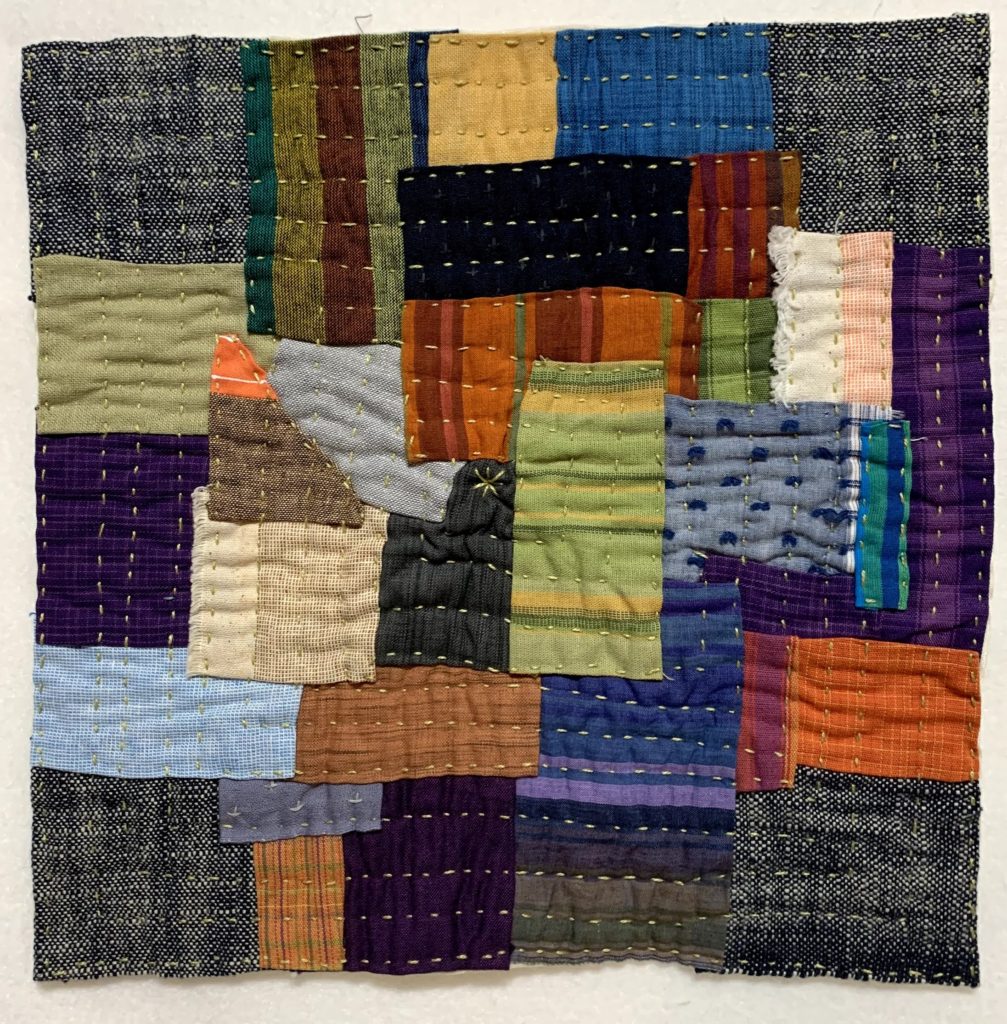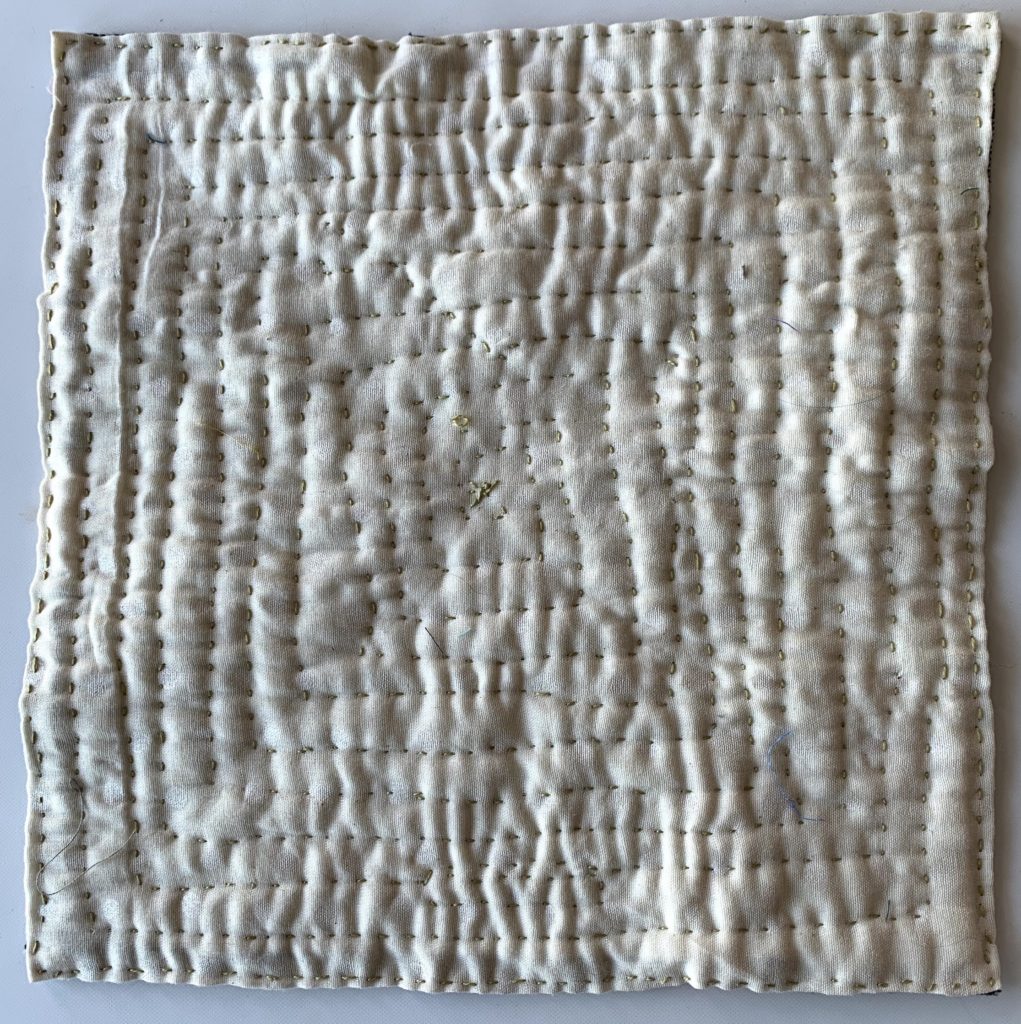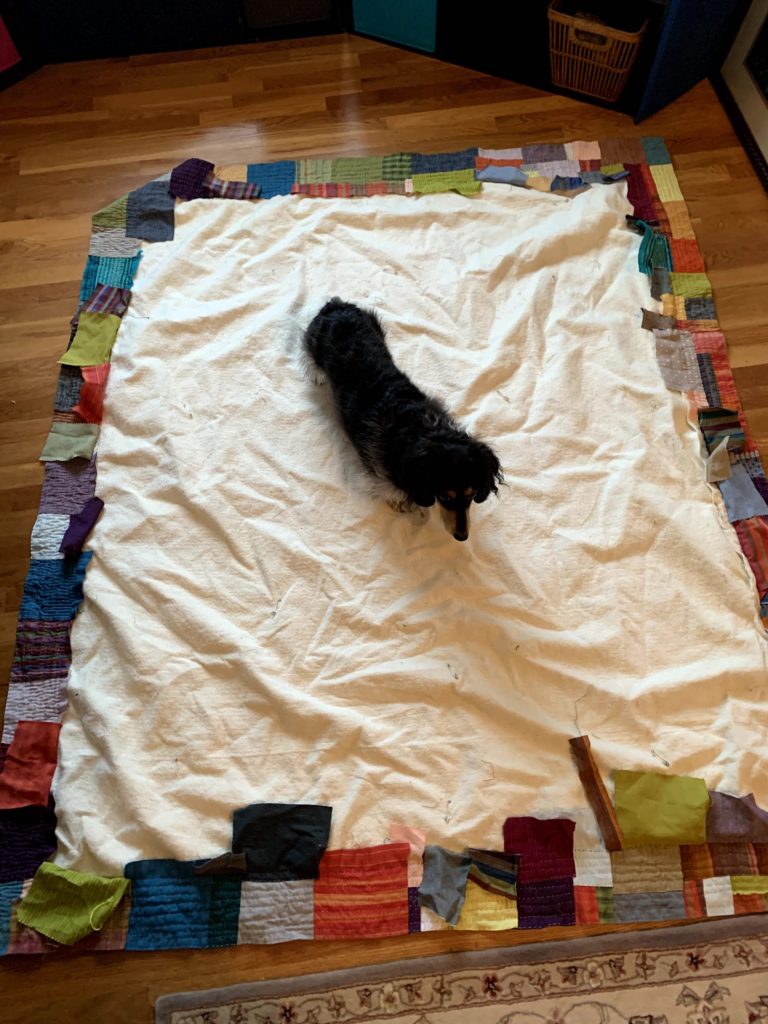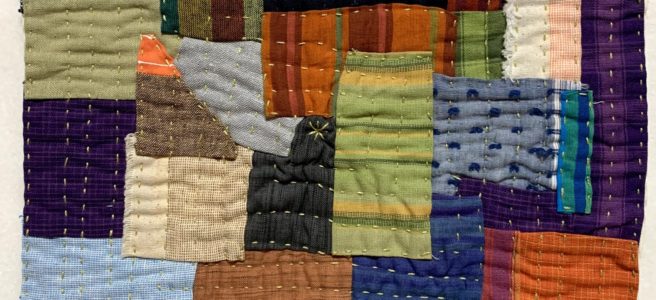For our February meeting, Quilt Lab is exploring Kawandi quilting. When they mentioned it as “Coming soon” in January, I was intrigued, and I did some research on my own. What I found really excited me.
Kawandi quilting is a traditional craft in western India, brought to that region via African slaves. The African tradition is called Siddi quilting, and I was not able to discover any significant difference between the two, although I will admit to not being a spectacular researcher.
The first resource I found was a demonstration on YouTube. It is pretty good, and explains the basics. I also found Margaret Fabrizio, who seems to have done a rather deep dive over years. I found her videos to be rather overpowering.
Sujata Shah teaches Siddi quilting. I’m most interested in learning from her, as she seems like a more authentic source of information on the traditional art.
What is Kawandi Quilting?
The traditional Kawandi is a hand-stitched quilt, made from scrap fabric, including old saris. One unique aspect is that it is assembled from the outside in. The edges are turned under and stitched together, and batting is laid inside. Then quilting proceeds in a spiraling line, about a finger width apart. New patches are laid on top as needed, with edges turned under.
It is accepted that there will be some bulk in the center of the piece, as you chase the loose batting to the center. That is called the belly of the quilt. I saw some mention of rice being put in there to “feed the quilt”, but not a large explanation, or the potential benefit. I skipped the rice in my pieces.
The last step is adding the Phula flowers to the corners. The ones I found are like a prairie point, stitched to the corner, with the raw edges out. I haven’t added it to my first piece yet, but I will. I’m not thrilled with the raw edges idea.
My Kawandi Quilt

This is my first piece. I started with a 12.5″ square of double gauze, a 12″ square of Warm and Natural cotton batting, and a pile of fabric scraps. I chose scraps from my collection of shot cottons, linens, linen blends, and other loosely woven fabrics. From experience, I know that they are more pleasant to hand stitch.
My quilting thread is a 12 weight Perle cotton, leftover from my Time is a Flat Circle quilt. I dearly love using up leftovers, in my studio AND my kitchen.

The hand of this piece is amazing. It is so soft and floppy, and is the first time I have enjoyed “Big Stitch” hand quilting. I found the quilt to be incredibly enjoyable to make. I think part of the pleasure was exploring something so unusual. The other part was that my expectations were low. I had no set idea of what I would come up with, so all output was good.
This one took me a few hours, and I was completely hooked. My imagination is sparking, and I know it will be a technique I explore further.
Kawandi Quilting by Machine
Next I checked out a tutorial by Mel Beach – Mel used her sewing machine to make her Kawandi. She also makes her phula with circles, which I will have to try out. Hers look great.

I gave machine kawandi a try, and I like that technique, too! Again, it finishes about 12″ square. These are a mix of Island Batik fabrics.

This yellow piece combines Kawandi quilting with last month’s Monochrome challenge. I plan to make a series of 9 small pieces and put them on a promising wall in the living room. Again, it is from my Island Batik bin.

Green!
My Future Kawandi Quilting Plans
I’ve been working on a larger hand-made version – it’s great to get cozy under the piece with Oscar and work on it when I need to relax. I consider this to be my “permission quilt”. I have permission to do whatever the heck I want with it. No rules, just soothing stitches. It is the exact opposite of my most recent, more stressful handmade top. I’ll share more on this one soon.

Mom got in on the Kawandi, too. She’s a bit of an over achiever, though, because her large piece is finished.

Things I wondered about Kawandi quilting before starting:
- Are the pieces appliquéd down? No. They are just quilted. If your finger is little, you can get it in between the rows of stitches.
- Will it fall apart? I don’t think so, but I haven’t washed mine yet.
- Where can I learn more? Sujata Shah teaches Siddi Quilting and offers virtual classes. I’m signed up for one in March. Yippee!
- Want to try the machine technique? Paula has a great machine piecing tutorial, and a clever way to get started.
Well, there you have it. Another successful month in Quilt Lab, and yet another aspect of quilting that I love.
Have you been trying out any new things? Tell me about them!
Want to see my latest post on Kawandi Quilting? Here it is!
Update:
Since I wrote this post in February of 2021, I learned so much more about Kawandi! You can take a virtual class with me at Gotham Quilts if Kawandi excites you, too.


This is awesome! I need to try Kawandi quilting. Thank you.
Carey
Thank you so much for sharing! This is the kind of project I need! I will definitely give it a try!
What interesting pieces and technique! I love the fun touches I see in your Mom’s…the hexagon, the selveges. From the outside in as a technique makes me a bit nervous but I love what you are doing with this. Also fun to see the machine versions and your mini IB pieces!
Thanks, Kathleen! Yeah, her’s is pretty special. It’s definitely outside of my comfort zone, but experimenting with something small removes the risk for me.
Great project! Thanks for your downright honest description. This sounds like something I’d love to make.
I love your monochromatic series. And your mom’s Kawandi quilt is also awesome. Although I’m not a fan of hexagonal… 😉
Thanks! They are a lot of fun – try it out!
What a great tutorial, thanks so much. It’s definitely my next project. Very inspiring.
That’s great to hear. Thank you! Tag me if you share your work online – I would love to see what you make.
Thanks for the info!!! Do you use double thread? And do you quilt all the way through?
Hi, Susan – I do not use double thread. The perle cotton is strong enough. And I do quilt all the way through.
These are beautiful! I’ve been fascinated with these for awhile now and I love yours – and your mom’s.Thanks for the link to the tutorial for hand piecing one. Seems like just what I need to get started.
Thanks for your sweet comment, Cindy. I am so glad you are going to give Kawandi a try. It is really wonderful.
Not sure how I came across your site, but I love this discovery and have “followed” you. Very intrigued, will explore past, and await future posts.
Thanks, Bonny! I hope I prove to be entertaining.
I love all the information you supplied in your post. Your quilts are amazing. I am finishing my first Kawandi quilt that is 20” x 30”. I am totally addicted to it. I really want to make a lap size one now but not sure if I am biting off more than I can chew. I love using up scraps since I have three big bins of them.
I am working on my third kawandi and I am obsessed! I was wondering how the Oscar quilt is coming along.
Lol. I’m so glad you are enjoying the process! The big one I was working on is coming along slowly. I’ll see if I can get a photo and update my progress on it this week. I slowed down with it in the summer time.
Clarifying: in the picture with Oscar, I think of the quilt you were working on as the Oscar quilt.
How did i not know about this until today? Perhaps because Kawandi quilting is indigenous to Western India, while i am from the East – Bangladesh. Bengal’s style of quilting is Kantha quilting, again with hand stitching, but it is whole cloth quilting, not patchwork. This is fascinating!
I’ve heard from other Indian people that Kawandi isn’t at all popular in India. I guess it all depends on where you are located. And Kantha is on my radar for exploration, but a lot of what I have found about it looks more like embroidery than quilting. Different textile traditions are so exciting.
I would love to take a class but can’t find one either in person or online. I may have to just jump in and try it without guidance. Thanks for your thoughts and information!
Hey, Teresa – It can be tough to find classes. I’ve started offering them at Gotham Quilts periodically. I will be adding a new one for either March or April soon.
If you cut the phula flower squares on the bias, they are less likely to ravel.
Interesting idea. I’ll check that out, although I still won’t be adding them to my kawandi pieces.
Wondering if I can use fusible fleece for law’s dinner quilting?
I suspect I’m reading an auto-correct here, and I’m going to guess that you are asking if you can use fusible fleece for less dense quilting. Since the quilting also holds to top together, I don’t think doing it farther apart is a good idea. I personally do not like to hand quilt through fusible fleece, as I find it to be too dense. However, you should try whatever you like with your quilt, and let me know how it works.
I enjoyed reading your experience of Kawandi. However I was very disappointed to hear about the machine sewing of Kawandi – it goes against everything I know about Kawandi….
Hi, Irene – I’m sorry machine stitching disappoints you. The beauty of quilting is that it evolves over time. We are all free to pursue the aspects of the craft that please us most.
Well said.
A question, what would be the biggest size you would make one of these pls.
The largest I have made is 60″ x 73″. I would not put an upper limit on size – they can be successfully made any size you can physically handle. I won’t be making a king-sized one for my bed, because I like smaller projects now, but it could certainly be done.
Hi from Holland! I just entered the amazing world of kawandi and this kind of work is absolutely fitting me!
I just finished my last ( 3rd) one, a big size, 180 x 130 cm. It is difficult to handle in the end but it went rather well. It took me 2 weeks, but only some hours a day doing it. (Though it was hard to stop!) .
I thought of starting a smaller one now from the centre to the outside and see how that works. In the end I will make filling and bottomlayer fitting at the edges and make the last row, then I add the wings at the end; now I always started with them on the 1st row, they seem rather essential to me.
On youtube are several movies about kawandi but not in Dutch and as I want to spread the joy of doing it I want to make a dutch short movie about it. Such fun!
I love your kawandis and wonder how the big one came!
Enjoyed your Zoom class with my Guild. But struggling to find the optimal needle. What is your favorite?
HI! My favorite needle is a Milliner’s #3. I get mine from SueSpargo.com